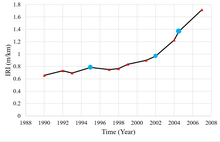
Levels of service (LOS) is a term in asset management referring to the quality of a given service. Defining and measuring levels of service is a key activity in developing infrastructure asset management plans.[2][3][4] Levels of service may be tied to physical performance of assets or be defined via customer expectation and satisfaction.[4][3] The latter is more service-centric rather than asset-centric. For instance, when measuring the LOS of a road, it could be measured by a physical performance indicator such as Pavement Condition Index (PCI)[1] or by a measure related to customer satisfaction such as the number of complaints per month about that certain road section.[2][5] Or in the case of traffic level of service, it could be measured by the geometry of road or by travel time of the vehicles, which reflects the quality of traffic flow. So, levels of service can have multiple facets: customer satisfaction, environmental requirements and legal requirements.[6]
- ^ a b Piryonesi S. Madeh; El-Diraby Tamer E. (2020-06-01). "Role of Data Analytics in Infrastructure Asset Management: Overcoming Data Size and Quality Problems". Journal of Transportation Engineering, Part B: Pavements. 146 (2): 04020022. doi:10.1061/JPEODX.0000175.
- ^ a b "Piryonesi, S. M. (2019). The Application of Data Analytics to Asset Management: Deterioration and Climate Change Adaptation in Ontario Roads (Doctoral dissertation)". Archived from the original on 2019-12-02.
- ^ a b "MFOA Ontario (2018). Asset Management Framework: A Guide to Asset Management for Municipalities in Ontario". Archived from the original on 2020-02-16.
- ^ a b El-Diraby, Tamer E.; Kinawy, Sherif; Piryonesi, S. Madeh (2017). "A Comprehensive Review of Approaches Used by Ontario Municipalities to Develop Road Asset Management Plans". Transportation Research Board.
- ^ "Piryonesi, S. M., & El-Diraby, T. (2018). Using Data Analytics for Cost-Effective Prediction of Road Conditions: Case of The Pavement Condition Index:[summary report] (No. FHWA-HRT-18-065). United States. Federal Highway Administration. Office of Research, Development, and Technology". Archived from the original on 2019-02-02.
- ^ "O. Reg. 588/17: ASSET MANAGEMENT PLANNING FOR MUNICIPAL INFRASTRUCTURE".